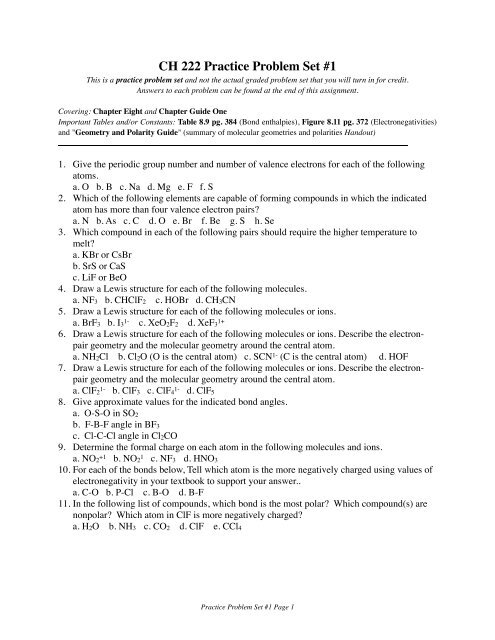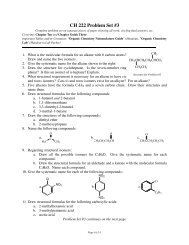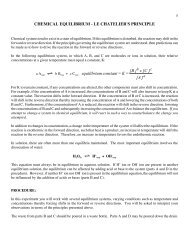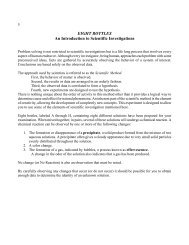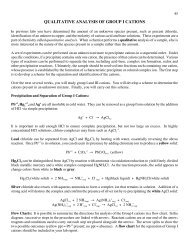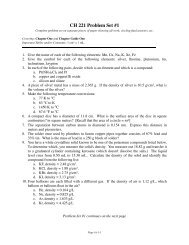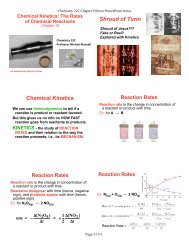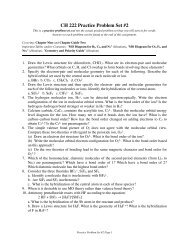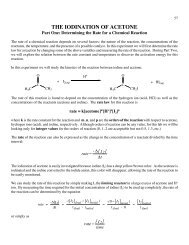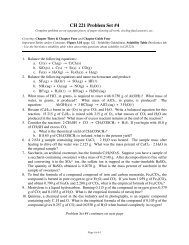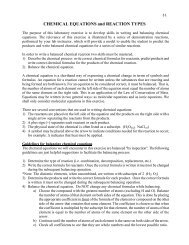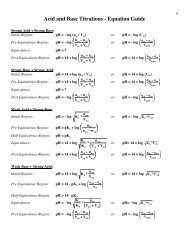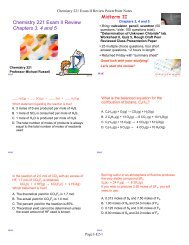Practice Problem Set #1
Practice Problem Set #1
Practice Problem Set #1
You also want an ePaper? Increase the reach of your titles
YUMPU automatically turns print PDFs into web optimized ePapers that Google loves.
CH 222 <strong>Practice</strong> <strong>Problem</strong> <strong>Set</strong> <strong>#1</strong><br />
This is a practice problem set and not the actual graded problem set that you will turn in for credit.<br />
Answers to each problem can be found at the end of this assignment.<br />
Covering: Chapter Eight and Chapter Guide One<br />
Important Tables and/or Constants: Table 8.9 pg. 384 (Bond enthalpies), Figure 8.11 pg. 372 (Electronegativities)<br />
and "Geometry and Polarity Guide" (summary of molecular geometries and polarities Handout)<br />
1. Give the periodic group number and number of valence electrons for each of the following<br />
atoms.<br />
a. O b. B c. Na d. Mg e. F f. S<br />
2. Which of the following elements are capable of forming compounds in which the indicated<br />
atom has more than four valence electron pairs?<br />
a. N b. As c. C d. O e. Br f. Be g. S h. Se<br />
3. Which compound in each of the following pairs should require the higher temperature to<br />
melt?<br />
a. KBr or CsBr<br />
b. SrS or CaS<br />
c. LiF or BeO<br />
4. Draw a Lewis structure for each of the following molecules.<br />
a. NF3 b. CHClF2 c. HOBr d. CH3CN<br />
5. Draw a Lewis structure for each of the following molecules or ions.<br />
a. BrF3 b. I3 1- c. XeO2F2 d. XeF3 1+<br />
6. Draw a Lewis structure for each of the following molecules or ions. Describe the electronpair<br />
geometry and the molecular geometry around the central atom.<br />
a. NH2Cl b. Cl2O (O is the central atom) c. SCN 1- (C is the central atom) d. HOF<br />
7. Draw a Lewis structure for each of the following molecules or ions. Describe the electronpair<br />
geometry and the molecular geometry around the central atom.<br />
a. ClF2 1- b. ClF3 c. ClF4 1- d. ClF5<br />
8. Give approximate values for the indicated bond angles.<br />
a. O-S-O in SO2<br />
b. F-B-F angle in BF3<br />
c. Cl-C-Cl angle in Cl2CO<br />
9. Determine the formal charge on each atom in the following molecules and ions.<br />
a. NO2 +1 b. NO2 1 c. NF3 d. HNO3<br />
10. For each of the bonds below, Tell which atom is the more negatively charged using values of<br />
electronegativity in your textbook to support your answer..<br />
a. C-O b. P-Cl c. B-O d. B-F<br />
11. In the following list of compounds, which bond is the most polar? Which compound(s) are<br />
nonpolar? Which atom in ClF is more negatively charged?<br />
a. H2O b. NH3 c. CO2 d. ClF e. CCl4<br />
<strong>Practice</strong> <strong>Problem</strong> <strong>Set</strong> <strong>#1</strong> Page 1
12. Three resonance structures are possible for dinitrogen monoxide, N2O.<br />
a. Draw the three resonance structures.<br />
b. Calculate the formal charge on each atom in each resonance structure.<br />
c. Based on formal charges and electronegativity, predict which resonance structure is the<br />
most reasonable.<br />
13. Give the bond order for each bond in the following molecules or ions.<br />
a. CH2O b. CO2 c. NO2 1+ d. CH4<br />
14. The compound oxygen difluoride is quite reactive, giving oxygen and HF when treated with<br />
water:<br />
OF2(g) + H2O(g) → O2(g) + 2 HF(g) ∆H°rxn = -318 kJ<br />
Using bond energies, calculate the bond dissociation energy of the O-F bond in OF2.<br />
15. Nitric acid, HNO3, has three resonance structures. One of them, however, contributes much<br />
less to the resonance hybrid than the other two. Sketch the three resonance structures and<br />
assign a formal charge to each atom. Which one of your structures is the least important?<br />
16. Draw the Lewis structure of ammonium nitrate.<br />
<strong>Practice</strong> <strong>Problem</strong> <strong>Set</strong> <strong>#1</strong> Page 2
Answers to the <strong>Practice</strong> <strong>Problem</strong> <strong>Set</strong>:<br />
1. Answers:<br />
a. O Group 6A 6 valence electrons<br />
b. B Group 3A 3 valence electrons<br />
c. Na Group 1A 1 valence electron<br />
d. Mg Group 2A 2 valence electrons<br />
e. F Group 7A 7 valence electrons<br />
f. S Group 6A 6 valence electrons<br />
2. b. As e. Br g. S h. Se (all third period or lower)<br />
3. a. KBr b. CaS c. BeO<br />
4. Answers:<br />
F<br />
a. F N F<br />
c. H O Br<br />
F<br />
H<br />
b. Cl C F<br />
d.<br />
H<br />
C<br />
C<br />
N<br />
5. Answers:<br />
H<br />
H<br />
F<br />
a.<br />
F Br F<br />
c.<br />
F<br />
+<br />
b. I I I<br />
–<br />
d.<br />
F<br />
Xe<br />
F<br />
6. Answers:<br />
H<br />
a. H N Cl<br />
c. S C N<br />
–<br />
electron pair geometry, tetrahedral<br />
molecular geometry, trigonal pyramidal<br />
electron pair geometry, linear<br />
molecular geometry, linear<br />
b. Cl O Cl<br />
d. H O F<br />
electron pair geometry, tetrahedral<br />
molecular geometry, bent<br />
electron pair geometry, tetrahedral<br />
molecular geometry, bent<br />
<strong>Practice</strong> <strong>Problem</strong> <strong>Set</strong> <strong>#1</strong> Page 3
7. Answers:<br />
F<br />
–<br />
a. F Cl F<br />
–<br />
c.<br />
F<br />
Cl<br />
F<br />
F<br />
electron-pair geometry, trigonal bipyramid<br />
molecular geometry, linear<br />
electron-pair geometry, octahedral<br />
molecular geometry, square planar<br />
b.<br />
F<br />
F Cl F<br />
d.<br />
F<br />
F<br />
F<br />
Cl<br />
F<br />
F<br />
electron-pair geometry = trigonal bipyramid<br />
molecular geometry, T-shaped<br />
8. a. 120° b. 120° c. 120°<br />
9. Answers:<br />
electron-pair geometry, octahedral<br />
molecular geometry, square pyramidal<br />
F<br />
a. O N O + c. F N F<br />
O = 6 – 4 – 1 /2(4) = 0 F = 7 – 6 – 1 /2(2) = 0<br />
N = 5 – 0 – 1 /2(8) = 1 N = 5 – 2 – 1 /2(6) = 0<br />
O<br />
b. O N O<br />
–<br />
d. H O N<br />
O<br />
O = 6 – 4 – 1 /2(4) = 0 H = 1 – 0 – 1 /2(2) = 0<br />
N = 5 – 2 – 1 /2(6) = 0 O = 6 – 4 – 1 /2(4) = 0<br />
O = 6 – 6 – 1 /2(2) = –1 N = 5 – 0 – 1 /2(8) = 1<br />
O = 6 – 4 – 1 /2(4) = 0<br />
O = 6 – 6 – 1 /2(2) = –1<br />
10. Answers:<br />
a. C—O O 2.5 - 3.5<br />
b. P—Cl Cl 2.2 - 3.2<br />
c. B—O O 2.9 - 3.5<br />
d. B—F F 2.0 - 4.0<br />
<strong>Practice</strong> <strong>Problem</strong> <strong>Set</strong> <strong>#1</strong> Page 4
11. Answers:<br />
Molecule<br />
∆χ for bond<br />
H2O O—H = 3.5 – 2.1 = 1.4<br />
NH3 N—H = 3.0 – 2.1 = 0.9<br />
CO2 O—C = 3.5 – 2.5 = 1.0<br />
ClF F—Cl = 4.0 – 3.0 = 1.0<br />
CCl4 Cl—C = 3.0 – 2.5 = 0.5<br />
(i) The bonds are most polar in H2O (biggest ∆χ)<br />
(ii) CO2 and CCl4 are nonpolar molecules.<br />
(iii) The F atom in ClF is more negatively charged.<br />
12. Answers:<br />
a. N N O N N O<br />
N<br />
N<br />
O<br />
b. N = 5 – 2 – 1 /2(6) = 0 N = 5 – 4 – 1 /2(4) = –1 N = 5 – 6 – 1 /2(2) = –2<br />
N = 5 – 0 – 1 /2(8) = 1 N = 5 – 0 – 1 /2(8) = 1 N = 5 – 0 – 1 /2(8) = 1<br />
O = 6 – 6 – 1 /2(2) = –1 O = 6 – 4 – 1 /2(4) = 0 O = 6 – 2 – 1 /2(6) = 1<br />
c. The first resonance structure is most reasonable (the most electronegative element, oxygen, has a<br />
negative formal charge).<br />
13. Answers:<br />
a. H2CO two carbon-hydrogen single bonds bond order = 1<br />
one carbon-oxygen double bond bond order = 2<br />
b. CO2 two carbon-oxygen double bonds bond order = 2<br />
c. NO2 + two nitrogen-oxygen double bonds bond order = 2<br />
d. CH4 four carbon-hydrogen single bonds bond order = 1<br />
14. 192 kJ/mol<br />
15. Answers:<br />
O (2)<br />
O O<br />
O (3)<br />
(1)<br />
O<br />
O<br />
O<br />
N<br />
O<br />
H O N O H O N O H<br />
O(1) = 0 O(1) = –1 O(1) = –1<br />
O(2) = –1 O(2) = 0 O(2) = –1<br />
O(3) = 0 O(3) = 0 O(3) = 1<br />
H = 0 H = 0 H = 0<br />
N = 1 N = 1 N = 1<br />
The third resonance structure is the least important since it has a positive formal charge on one of the<br />
oxygen atoms.<br />
16.<br />
<strong>Practice</strong> <strong>Problem</strong> <strong>Set</strong> <strong>#1</strong> Page 5


